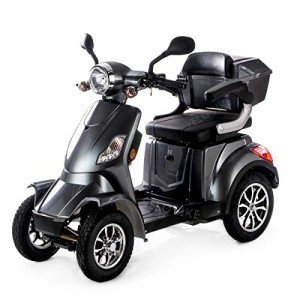A Comprehensive Guide to Buying a Mobility Scooter
Mobility scooters have become a crucial tool for lots of individuals seeking to boost their independence and mobility. With a huge array of designs and functions available, picking the ideal mobility scooter can be intimidating. This post supplies an informative guide to help consumers browse their choices, evaluate their requirements, and make an informed purchase.
Comprehending Mobility Scooters
Mobility scooters are electric vehicles developed for people who experience mobility challenges. They are especially advantageous for elders, those with specials needs, or individuals recovering from injuries. Mobility scooters can vary commonly in terms of design, features, and pricing.
Kinds Of Mobility Scooters
Before starting a purchase, it's important to comprehend the different types of mobility scooters available:
Three-Wheel Scooters:
- Generally more maneuverable in tight spaces
- Lightweight and portable
- Suitable for indoor usage
Four-Wheel Scooters:
- Offer greater stability and balance
- Suitable for outside usage over various terrains
- Generally have a longer battery life
Foldable/Portable Scooters:
- Designed to be easily transported and stored
- Can typically fit in the trunk of a vehicle
- Perfect for those who travel often
Sturdy Scooters:
- Built to accommodate larger people
- Typically featured more robust functions for outside usage
- Usually geared up with larger batteries for prolonged variety
Elements to Consider When Buying a Mobility Scooter
1. Weight Capacity
Pick a mobility scooter that can support the user's weight. The majority of scooters have a weight limitation varying from 250 to 500 pounds. It is important to guarantee that the scooter can accommodate the user comfortably.
2. Range and Battery Life
The variety is how far the mobility scooter can travel on a single charge. Normal varieties vary in between 10 to 30 miles. Think about the user's everyday activities and pick a scooter with an appropriate variety.
3. Scooter Dimensions
Consider the size of the scooter, including its weight and dimensions. A more compact scooter may be perfect for narrow hallways and tight areas, while larger models offer extra stability and comfort.
4. Terrain Capability
Examine where the scooter will primarily be utilized. If the user prepares to travel mainly on pavement, a lightweight model may be sufficient. Nevertheless, if the user needs to traverse gravel or unequal surface areas, think about a four-wheel scooter built for off-road usage.
Top Features to Look For
Convenience
- Adjustable Seats: Look for scooters with cushioned and height-adjustable seats to guarantee comfort throughout travel.
- Armrests: These improve security and support while navigating.
Security and Visibility
- Headlights and Taillights: Essential for nighttime use.
- Turn Signals and Reflectors: Improve exposure and security while on the roadway.
User-Friendly Controls
- Joystick or Drive Controls: These need to be intuitive and easy to manipulate.
- Easy-to-Read Displays: A control panel that reveals battery life, speed, and range can boost the user experience.
Extra Features
- Storage Compartments: These use included benefit for bring individual products while on the go.
- Weather Protection: Consider designs with rain covers or windshields if utilized in variable weather condition conditions.
Expense Considerations
When budgeting for a mobility scooter, prices can range anywhere from ₤ 500 to over ₤ 5,000 depending on the design, functions, and brand name. Extra costs might include:
- Extended Warranty: Protects against defects and can conserve cash in the long run.
- Devices: Optional functions, such as updated seats, lights, or storage solutions.
| Function | Expense Range |
|---|---|
| Fundamental Models | ₤ 500 - ₤ 1,500 |
| Mid-Range Models | ₤ 1,500 - ₤ 3,000 |
| High-End Models | ₤ 3,000 - ₤ 5,000 |
Financing Options
Numerous retailers offer financing strategies, and some regional government efforts might offer grants or support for those in requirement. Examine prospective financial help with community resources or mobility service companies.
Frequently asked questions about Buying a Mobility Scooter
What is the distinction between a mobility scooter and a wheelchair?
Mobility scooters are motorized and enable users to browse independently, while wheelchairs may require physical help or manual operation.
How do I maintain a mobility scooter?
Routine maintenance involves inspecting battery life, cleaning the scooter, and inspecting tires and brakes. Always describe the user manual for specific guidelines.
Can mobility scooters be utilized indoors?
Yes, numerous designs are created for both indoor and outside use. Nevertheless, three-wheel scooters tend to be much better matched for indoor navigation due to their tighter turning radius.
Are mobility scooters covered by insurance?
Some insurance coverage prepares cover a portion of the expenses for mobility scooters if they are deemed clinically required. Contact your supplier for specific information.
How quickly can a mobility scooter go?
Many mobility scooters have a maximum speed varying from 4 to 8 miles per hour. Nevertheless, the proper rate might differ depending upon regional regulations.
Buying a mobility scooter can significantly improve one's independence and lifestyle. By understanding the types, features, and expenses related to mobility scooters, prospective buyers can make knowledgeable decisions that fit their requirements and choices. Customization and thorough research study are essential to ensuring complete satisfaction with this important investment.

